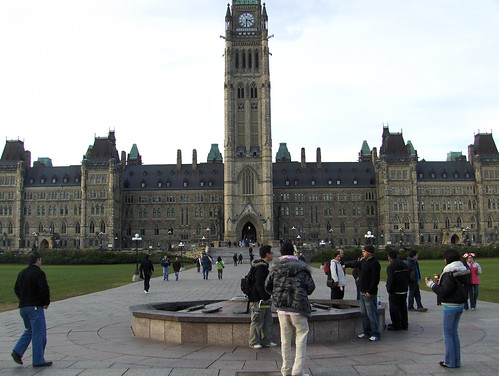
I took the train to Ottawa a few weeks ago, a city I’ve only visited on two other occasions (once to write a story about the G20 Summit in November of 2001, when the city was in a just-post-9/11 security freak-out). Ottawa was tranquil on this recent visit, and I spent most of it wandering around on foot, getting to know a city I feel like I know but don’t, apart from its role as our capital. After an obligatory trip to Parliament Hill to see the Eternal Flame and the statue of Lester B. Pearson, I went for long multi-hour walks through its various neighbourhoods.
What struck me most is that behind the big and impressive chunks of the Federal Government, Ottawa is a sort of standard Ontario city — a little rundown in spots, but nice — and reminded me a lot of Windsor. Instead of an army of skilled and (often) highly paid industrial workers, Ottawa is full of bureaucrats (so there isn’t the heavy industry) — and though largely immune to the kind of economic slump Windsor is experiencing right now, Ottawa felt a lot like my hometown does. Perhaps where Windsor is at the mercy of the automobile industry, Ottawa — the city — suffers from negative forces it too doesn’t fully control, like the National Capital Commission. Check the NCC Watch site that documents some of the blows this federal body has delivered to Ottawa’s urban landscape over the years, including the removal of its grand downtown railway station, just steps from The Hill, for a downtown expressway. The new (1966) train station is a beautiful modernist gem built by John Parkin, but is located far from the city centre. One of the finest urban moments in many cities is getting off a train and walking out into the middle of it. Ottawa used to have that.

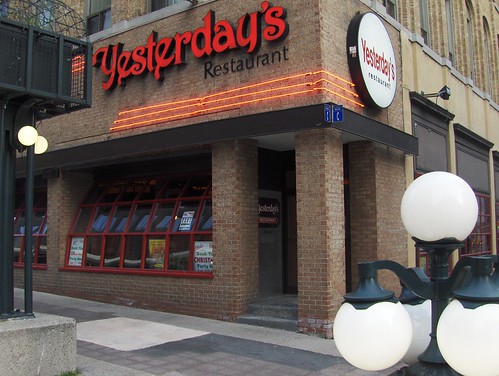
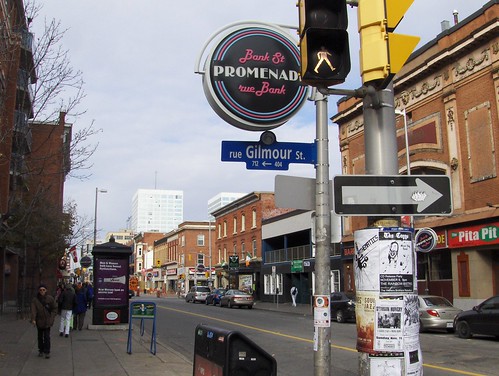
I ran into a lot of signage — public and private — that had a certain 1978 quality about it. I liked it, but possibly out of nostalgic feelings for a childhood spent surrounded by these sorts of fonts and images.
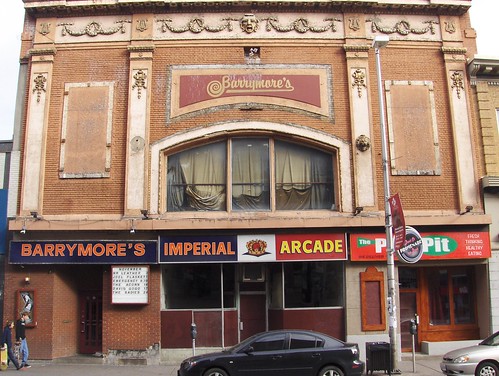
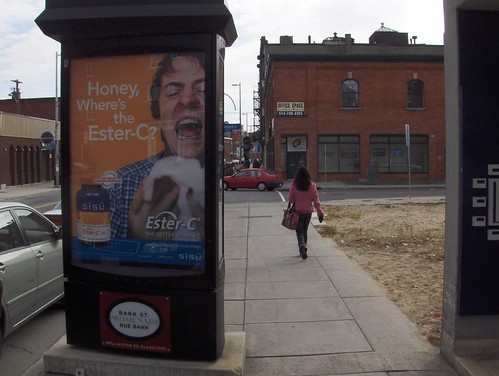
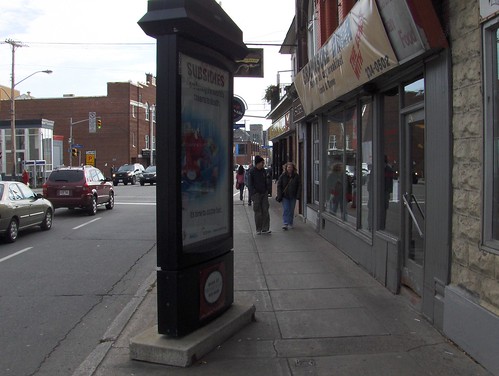
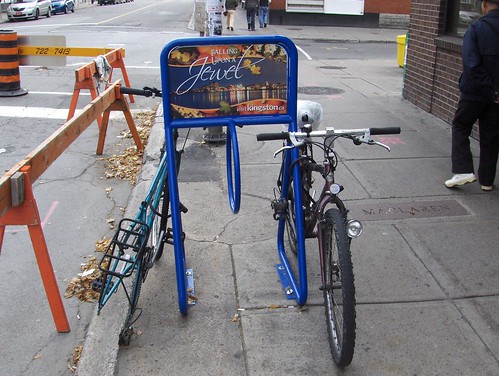
Along the “Bank Street Promenade” are monster advertising slabs that look a lot like the universally condemned monster garbage cans Toronto tested, but without the rubbish bin. They were scattered along the sidewalk for a kilometer or two, some blocking the sidewalk, others askew, as if the truck that brought them just slowed down and pooped them out haphazardly. The bike racks were functional enough but were made rather ugly and intrusive with the advertising (no offense to the the good city of Kingston). The cross streets were marked in stone laid into the sidewalk — a nice touch.
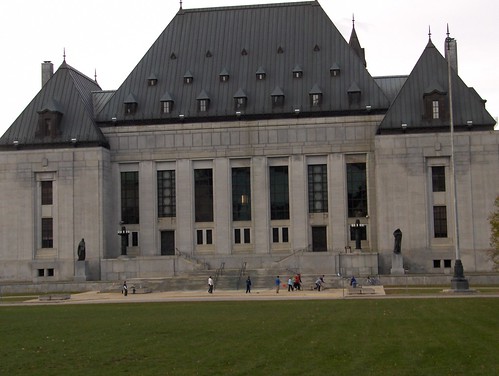
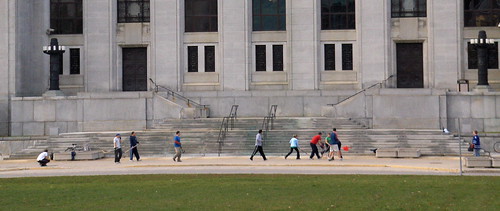
A nice Canadian moment, played out in front of the Supreme Court building. Public access to the grounds around capital buildings like this is refreshing. It’s sad that this might change at some point, but even in the age of terror, we can still get physically close to our government.

Not so at the American Embassy where security concerns have required spiked fences, bollards and an ugly concrete barricade that takes up an entire lane of Sussex Avenue.
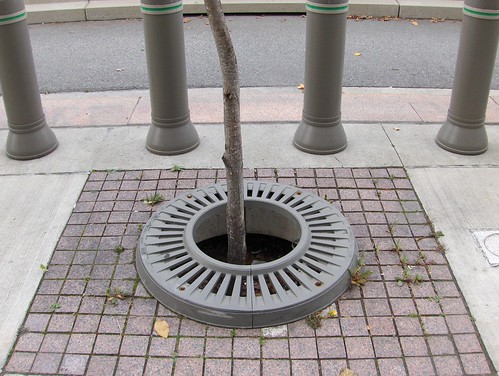
The tree pits have some breathing room though, and keep the soil from being compacted.
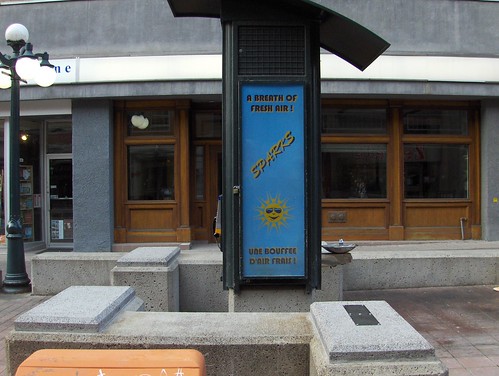
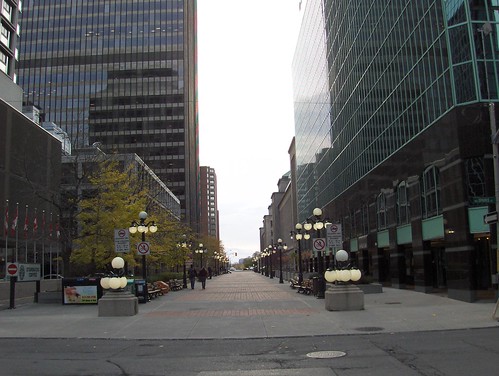

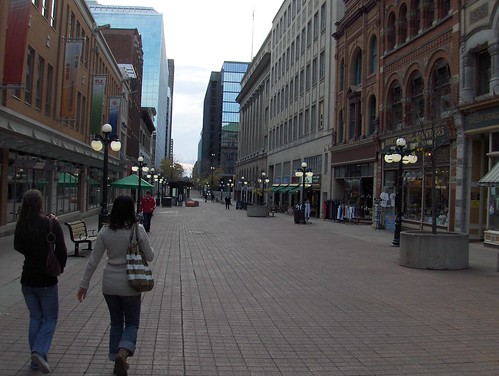
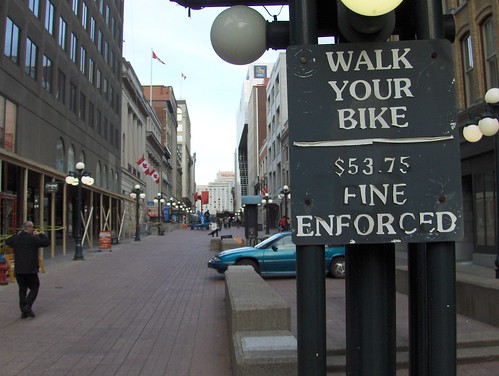
If Toronto is ever to get pedestrian only zones, planners should always keep the Sparks Street Mall at their elbow in order to avoid this kind of urban sterilization. It was conspicuously deserted on sunny Saturday and Sunday afternoons. I appreciated more of those 1978ish elements, but many were neglected. Poor Sparks Street, let’s never do this.


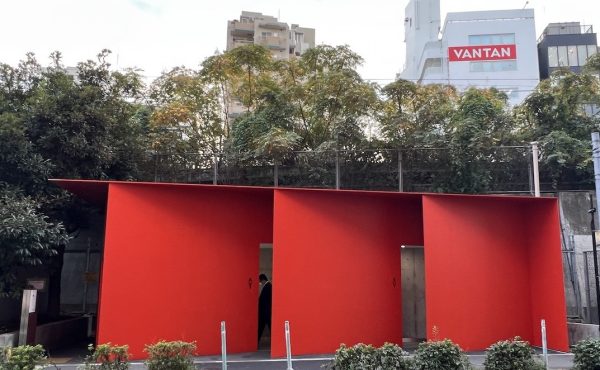

15 comments
Those advertising pillars on Bank Street are terrible. They don’t even attempt to be useful.
Sparks Street is pretty sad, too. Ottawa should look to Calgary for inspiration on how to revive its main pedestrian street, which suffered from a similarly bad design from the 1970s-early 1990s but has since been successfully reconfigured.
I wonder if there’s any way to tunnel below the highway to get the trains back into the old Ottawa station. Might require a bit of engineering magic, but it would certainly be worth it.
Sparks street is always seen as absolute failure but it really isn’t.
One of the reasons it might have been deserted on the weekend is because it’s surrounded by government and large corporate offices, both of which are empty on Saturdays and Sundays. It is often crowded during the summer and it’s always great to see streets with no cars on them.
It is only a few blocks from Sparks street to the Byward market in Ottawa, which also has pedestrian-only streets. It is important to note that the Byward market is a mixed-use neighborhood, encompassing a variety of stores (produce, restaurants, and retail stores) that cater to different economic groups.
Sparks street did not “gentrify” because it is pedestrian only, neither can the lack of cars be held responsible for it desolation during the winter weekends. Sparks street caters mostly to tourists and employees on their lunch breaks. It is no wonder why it lacks the same vitality and character as the Byward.
shaun> I agree in part — during weekday lunches I’m sure it’s crowded, just as Toronto’s PATH system is. But it used to be mixed use, and now it isn’t. I’d say judging Sparks street before and after the transformation, it’s a failure — but perhaps part of a large downtown Ottawa planning failure. That is hasn’t received the attention and care it deserves doesn’t help. A few blocks a way, on Elgin or Bank, there is a mix of uses. In redeveloping Sparks, there seemed to be too much makeover/cleanup in that 1970s urban renewal sort of way.
This was also the weekend before Halloween — nice fall days.I guess nearly a month ago now, not the couple weeks I thought. Time flies, etc.
I love restaurants called Yesterday’s! Always makes me wonder if the food is past its expiry date.
One cold, snowy November I decided to do what Ed Broadbent said every Canadian should do – made snow angels on Parliament Hill. We then roasted marshmallows on the Centennial Flame and went for a late night stroll around the back of Centre Block.
Ottawa is 1978 because it is so laid back and little of that paranoia that came later with the fear of terrorism attacks. Washington wasn’t as bad as I thought either, but there was that sense of Big Brother watching that Ottawa doesn’t have.
Let’s judge “regular” thoroughfares by the same standards as pedestrian malls, i.e. if a street isn’t thronged with motor vehicles 24/7 it shall be deemed a gross failure and converted to pedestrian/bike or mixed-traffic.
Listen, ‘shaun’ or whoever you are, Spark’s Street is an absolute failure by any yardstick. It is exactly the 1970s style dismal wasteland shown in Shawn’s photographs. Even when it is busy (a rare event) it is still dead. If it is summer (a measly 10 weeks at best) and lunch time during a weekday, you will see a few bored office workers trying to kill their lunch hour break but there is no scene which you might want to hang around and experience. Spark’s Street, in fact, is so bad that it is laughable and about the only thing you can say in its defense is that it is only part of a wider failure that has left Ottawa as one of the most boring places on the planet.
Really interesting perspective. Kind of reminds me of London a bit.
Ryan> Yes, London might be an even more apt comparison because they are both white collar towns. What I’m finding, though, is outside of Toronto, Ontario cities have a certain Ontarioness too them — that sounds stupid and obvious, but something like, more things in common than not, or a particular sensibility. Will figure out how to articulate this one day.
Daemon> Pedestrian areas are good, but there can be a way to make them more dynamic rather than what is the equivalent of an outdoor PATH system, there for one use, for a few hours a day. I like the PATH for a lot of other reasons, though. Sparks street, being what was once the bustling main street of Ottawa, deserved better.
If anything, Sparks Street is more the victim of the eclipse of the Kresge/Woolworth school of urban retail, or of sitdown lunch spots from a pre-McDonald’s era, or simply of an age before “business casual” became the norm. Its success really depended on a pre-70s school of commonplace urban decorum–if you can channel back to its beginnings, you can see how it (and a lot of other well-meaning 50s/60s urban planning) could be/have been regarded as a success.
And it has nothing to do with Byward-style 24/7 trendiness; in fact, if you want to know where the kind of main-street retail experience Sparks once represented decamped to, head for the Rideau Centre instead…
To the Sha*ns: Sparks Street is indeed a failure. Because Sparks isn’t really on the way to anything, and it isn’t a destination in itself, it dries up outside of business hours.
There was a move afoot a few years ago to rezone Sparks to allow dwellings over the stores. For whatever reason, that idea quietly disappeared.
Your pictures missed out on a few of my favourite spots around town: the Market, Elgin, the Glebe, the bike path behind Parliament Hill, the paths on the Rideau Canal and Ottawa River.
Erigami> I passed through the Market and Elgin (and Hintonberg) after the sun had set, and my night-camera-skills are low. I think I was holding a coffee when I was going through the Glebe, so I didn’t take pictures.
Here are some more though:

Ron Ron Mueck at the National Gallery, nicely overlooking Ottawa.
Above the locks.
Former RR station.
Frank Clair Stadium, South Glebe (Finished coffee at this point)
To David who wondered about getting trains back downtown:
There has been significant debate, particularly during the last municipal election, towards expanding the city’s Transitway (the East-West, and increasingly Southern, bus route) to include more light rail. The O-Train was the first instance of this but it only spanned a short distance of pre-existing track going from North-South with stations at inconvenient locations (Bayview, Carling, Confederation). The plan was to somehow extend the O-Train outwards to the rapidly developing South and also to ease East-West traffic, especially downtown. I recall one of the proposals was to dig a tunnel for light-rail underneath the downtown core from about LeBreton Flats to the old train station (what is now the Government Conference Centre) or Sandy Hill.
After the election, the plans got derailed and now the city seems to be facing a lawsuit for breaching its contract with Siemens (train manufacturer).
Check out Friends of the O-Train for more specific info:
http://www.friendsoftheotrain.org/
and, obviously, Ottawa’s own (http://en.wikipedia.org/wiki/Simon_Pulsifer), Wikipedia:
http://en.wikipedia.org/wiki/O-Train
-Matt
p.s. Yesterday’s does indeed live up to its name.
In your next Ottawa piece, you may want to take a look at the old U.S. Embassy on Wellington St. directly across from the parliament buildings.The previous federal gov’t spent over $11 million on studies and prep work to transform this very handsome edifice into the new National Portrait Gallery.
The Harper gov’t has decided to abandon this worthwhile project and is now calling on private developers to supply a “public exhibition facility” in one of the following cities : Halifax, Quebec City, Montreal, Ottawa, Toronto, Winnipeg, Edmonton, Calgary or Vancouver.
The location of all the world’s national portrait galleries are in the nations’ capitols. That is where ours should be… in a significant architectural setting. Let’s hope that there is enough outrage concerning this issue that the government changes its mind. Who wants to see Canada’s historical personages hanging in the West Edmonton Mall?